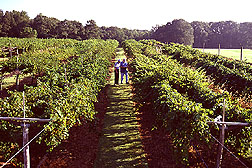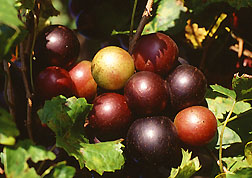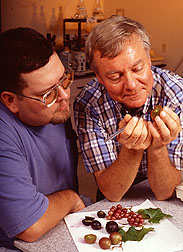America's First Grape: The Muscadine
|
|
They were as wild and untamed as the land they covered. In 1584 Sir Walter Raleigh described them as being "on the sand and on the green soil, on the hills as on the plains, as well as on every little shrub ... also climbing towards the tops of tall cedars ... in all the world the like abundance is not to be found."
This early English explorer had landed on the coast of North Carolina and was describing muscadine grapes, Vitis rotundifolia, the bronze or purple-black fruit that was growing profusely throughout what is now the southeastern United States. Today, more than 400 years later, scientists with USDA's Agricultural Research Service and Mississippi State University have even more reason to be excited about the muscadine. Research conducted by ARS horticulturist James B. Magee and Mississippi State nutritionist Betty J. Ector predicts that the muscadine will not only be an alternative crop for growers in the Southeast, but a new health food as well.
Magee and Ector have found significant amounts of resveratrol the compound in French red and white wines that is being touted as an agent for lowering cholesterol levels and the risk of coronary heart disease—in the skin, pulp, and seeds of these grapes.
In a study reported January 1997 in Science, researchers at the University of Illinois at Chicago purified resveratrol from grape sources and showed it to have anticarcinogenic activity, meaning that it inhibits tumor promotion. Muscadines also contain ellagic acid, a natural organic compound thought to inhibit the start of cancer caused by certain chemicals. [See "Building a Better Strawberry," Agricultural Research, September 1991, pp. 24-25; and "Boosting Ellagic Acid in Strawberries," Agricultural Research, August 1997, pp. 17-18.]
Potential New Crop, New Jobs
Lanny Bateman, an economist with Mississippi State University, estimates that in Mississippi, 1,000 acres of muscadines would create 56 to 62 additional jobs in related business, or more than half a million dollars in income from the farm investment alone. One million gallons of juice would also generate $7 million in gross sales in related industries, including bottling, labels, equipment and repairs, and marketing.
"But," Bateman says, "shifting to a new enterprise can be difficult for a farmer, particularly if growing alternative crops involves new technology that is costly or time consuming. And there is often a tendency to confuse capability of growing a crop with the ability to market it."
Neither of these problems pertains to growing muscadine grapes in the Southeast. According to Bateman, a variety of products are being developed from muscadines that will potentially appeal to a wide range of consumers.
|
|
"The muscadine, which is called scuppernong locally, was the first native American grape to be cultivated," Magee says. "Many native Southerners can recall hearing about old-time muscadine hull pies. Production in the past has been primarily for home use—for juice, wine, and as fresh fruit. But small and part-time farmers can grow this crop commercially. Lack of markets has been the limiting factor."
How Do Your Muscadines Grow?
At the ARS Small Fruit Research Station in Poplarville, Mississippi, horticulturist Jim Spiers and former ARS scientist William Olien developed cultural practices that help muscadine vines become established.
Although mature vines grow vigorously, they can be difficult to get started. ARS scientists found that planting vines in larger holes so roots can avoid the smooth or polished inner soil surface of auger-drilled holes increased the rate of plant survival. [See "Reviving an American Tradition," Agricultural Research, August 1990, p. 9.] This, along with pruning sparingly and adding peat to the soil, can produce a commercial crop in 3 years, whereas conventional practices take 5.
"Muscadines grow best in fertile sandy loam and alluvial soils. They grow wild in well-drained bottom lands that aren't subject to extended drought or waterlogging," Magee reports. "They're also resistant to pests and diseases, including Pierce's disease, which can wipe out other species of grapes. And muscadines are one of the grape species most resistant to phylloxera, an insect that can kill roots of grapevines," he says.
Relatively drought tolerant, the muscadine will have a long life in good sites. And, according to Magee, good management and good varietal choice give growers very high yields of 8 to 12 tons of grapes per acre. Mature vineyards of improved varieties can yield up to 18 tons per acre. Muscadines grow best in areas where temperatures don't go below 0oF.
A Health Food
Muscadines are now marketed as juice, jellies, jams, preserves, syrups, and dessert toppings.
In processing muscadines, about 900 to 1,000 pounds of waste come from each ton. Muscadines have tough, thick skins and yield less juice than other grapes, leaving the skin, pulp, and seeds as waste, or pomace. Some of this is used as fertilizer and livestock feed. But most remains to be disposed of in an environmentally acceptable way.
Betty J. Ector has big plans for the muscadine. In research jointly funded by USDA, the Mississippi State University nutritionist found that a puree of muscadine skins and pulp is an excellent source of resveratrol, dietary fiber, and some essential minerals and is high in carbohydrates and low in fat and protein.
|
|
"We found that powdered muscadine puree has more dietary fiber than oat or rice bran," Ector says. "And we know that high fiber consumption lowers blood pressure, serum triglycerides, and both total and LDL (bad) cholesterol levels. It also protects against coronary heart disease, gastrointestinal diseases, and colon cancer. Soluble fiber has extra benefits for diabetics by delaying glucose absorption and increasing the sensitivity of skeletal muscles to insulin."
In a study at Mississippi State University in which rats were fed diets containing three levels of powdered muscadine pomace puree, Ector found that those eating the muscadine showed significantly lower LDL cholesterol levels and higher HDL (good) levels than a control group.
Statistics show that French consumers drink a lot of wine and eat a lot of dietary fat, yet have low incidence of coronary heart disease. Researchers say that resveratrol in red wine probably accounts for this. Resveratrol is a phytochemical in grapes and other plants that helps protect them from attack by pests or diseases.
"If you don't drink wine, try some jam or a muffin made from muscadines," says Ector. "They're an even better source of resveratrol. One-half serving (2 fluid ounces) of unfiltered muscadine juice, one serving of muscadine jam, one medium muffin, or one-tenth serving of muscadine sauce contains about the same amount of resveratrol as 4 fluid ounces of red wine.
"We're also trying it as additive to beef patties containing 15 to 20 percent fat," Ector reports. "Eating foods made with muscadine products is a good way to get a significant amount of resveratrol in the average diet. And they taste great!" — By Doris Stanley,
USDA-ARS Small Fruit Research Station, P.O. Box 287, Poplarville, MS 39470; phone (601) 795-8751









